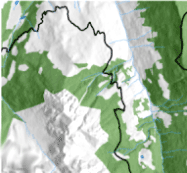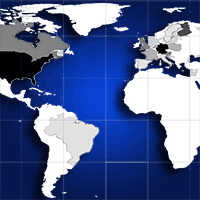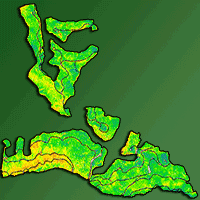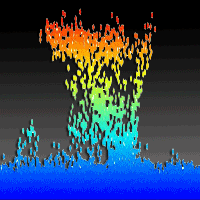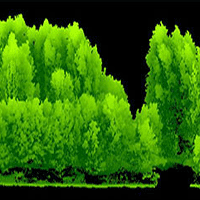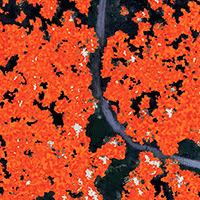
Efficient measurements of basal area in short rotation forests based on terrestrial laser scanning under special consideration of shadowing
Dominik Seidel , Christian Ammer
iForest - Biogeosciences and Forestry, Volume 7, Issue 4, Pages 227-232 (2014)
doi: https://doi.org/10.3832/ifor1084-007
Published: Mar 10, 2014 - Copyright © 2014 SISEF
Research Articles
Abstract
Terrestrial laser scanning has been used in forest research for about ten years and use-orientated applications are of increasing importance. The effect of shadowing in single location laser scanning, e.g., as used for biomass estimations, has not been quantified so far even though it affects the quality of information derived from the laser scans. In our study we quantified the effect of shadowing on automated basal area measurements in a densely stocked poplar short rotation forest and developed a method to correct unsampled areas. We found that on average about 5.0 ± 2.5% of the plot area (12.56 m²) was not sampled by the laser scanner due to shadowing. Efficient basal area measurements based on terrestrial laser scanning were possible and if a correction factor was derived from the scan data, the effects of shadowing could be accounted for. The relative mean absolute error could then be lowered from 9.8% to 8.4%. This new method allows fast, fully objective, and precise plot-level measurements of basal area considering the effects of shadowing. It could be applied in the future to support monitoring growth developments in densely stocked stands such as short rotation forests.
Keywords
Ground Based LiDAR, Non-detection Bias, Angle Count Method, Poplar Short Rotation Forest
Authors’ Info
Authors’ address
Christian Ammer
Chair of Silviculture and Forest Ecology of the Temperate Zones, Faculty of Forest Science and Forest Ecology, University of Göttingen, Büsgenweg 1, 37077 Göttingen (Germany)
Corresponding author
Paper Info
Citation
Seidel D, Ammer C (2014). Efficient measurements of basal area in short rotation forests based on terrestrial laser scanning under special consideration of shadowing. iForest 7: 227-232. - doi: 10.3832/ifor1084-007
Academic Editor
Agostino Ferrara
Paper history
Received: Jul 25, 2013
Accepted: Feb 09, 2014
First online: Mar 10, 2014
Publication Date: Aug 01, 2014
Publication Time: 0.97 months
Copyright Information
© SISEF - The Italian Society of Silviculture and Forest Ecology 2014
Open Access
This article is distributed under the terms of the Creative Commons Attribution-Non Commercial 4.0 International (https://creativecommons.org/licenses/by-nc/4.0/), which permits unrestricted use, distribution, and reproduction in any medium, provided you give appropriate credit to the original author(s) and the source, provide a link to the Creative Commons license, and indicate if changes were made.
Web Metrics
Breakdown by View Type
Article Usage
Total Article Views: 58891
(from publication date up to now)
Breakdown by View Type
HTML Page Views: 48379
Abstract Page Views: 4736
PDF Downloads: 4333
Citation/Reference Downloads: 24
XML Downloads: 1419
Web Metrics
Days since publication: 4298
Overall contacts: 58891
Avg. contacts per week: 95.91
Citation Metrics
Article Citations
Article citations are based on data periodically collected from the Clarivate Web of Science web site
(last update: Mar 2025)
Total number of cites (since 2014): 30
Average cites per year: 2.50
Publication Metrics
by Dimensions ©
Articles citing this article
List of the papers citing this article based on CrossRef Cited-by.
References
Yield improvements through modification of planting density and harvest frequency in short rotation coppice Salix spp. 1. Yield response in two morphologically diverse varieties. Biomass and Bioenergy 22 (1): 15-25.
CrossRef | Gscholar
Quantifying environmental effects of Short Rotation Coppice (SRC) on biodiversity, soil and water. IEA Bioenergy, Task 43, 2011/01, International Energy Agency, pp. 34.
Online | Gscholar
QR Factorization. Numerical linear algebra for applications in statistics. Springer-Verlag, Berlin, Germany, pp. 95-97.
Gscholar
Bioenergi - ny energi för jordbruket [Bioenergy - new energy from agriculture]. Rapport 2006:1, Swedish Board of Agriculture and Plant Protection, Jönköping, Sweden, pp. 81. [in Swedish]
Gscholar
Modelling single trees from terrestrial laser scanning data in a forest reserve. The Photogrammetric Journal of Finland 21 (7): 37-50.
Gscholar
Ertragsermittlung und Potenziale von Agrarholz. Forst und Holz 6: 18-23.
Gscholar


